GSSC 1159 - Dramaturgical Analysis: Social Setting of KFC Restaurants
VerifiedAdded on 2023/04/21
|11
|3387
|190
Report
AI Summary
This report uses participant observation and dramaturgical theory to analyze social interactions within KFC restaurants. The study explores how individuals behave in this fast-food setting, focusing on aspects like impression management, symbolic interactionism, and the influence of the social environment on eating habits. Observations include differences in food choices and consumption patterns between men and women, the impact of group dynamics on restaurant selection, and varying consumer priorities such as price, appearance, and social environment. The research highlights how KFC serves as a social space where individuals express and sustain relationships while navigating social expectations and meanings associated with food choices.
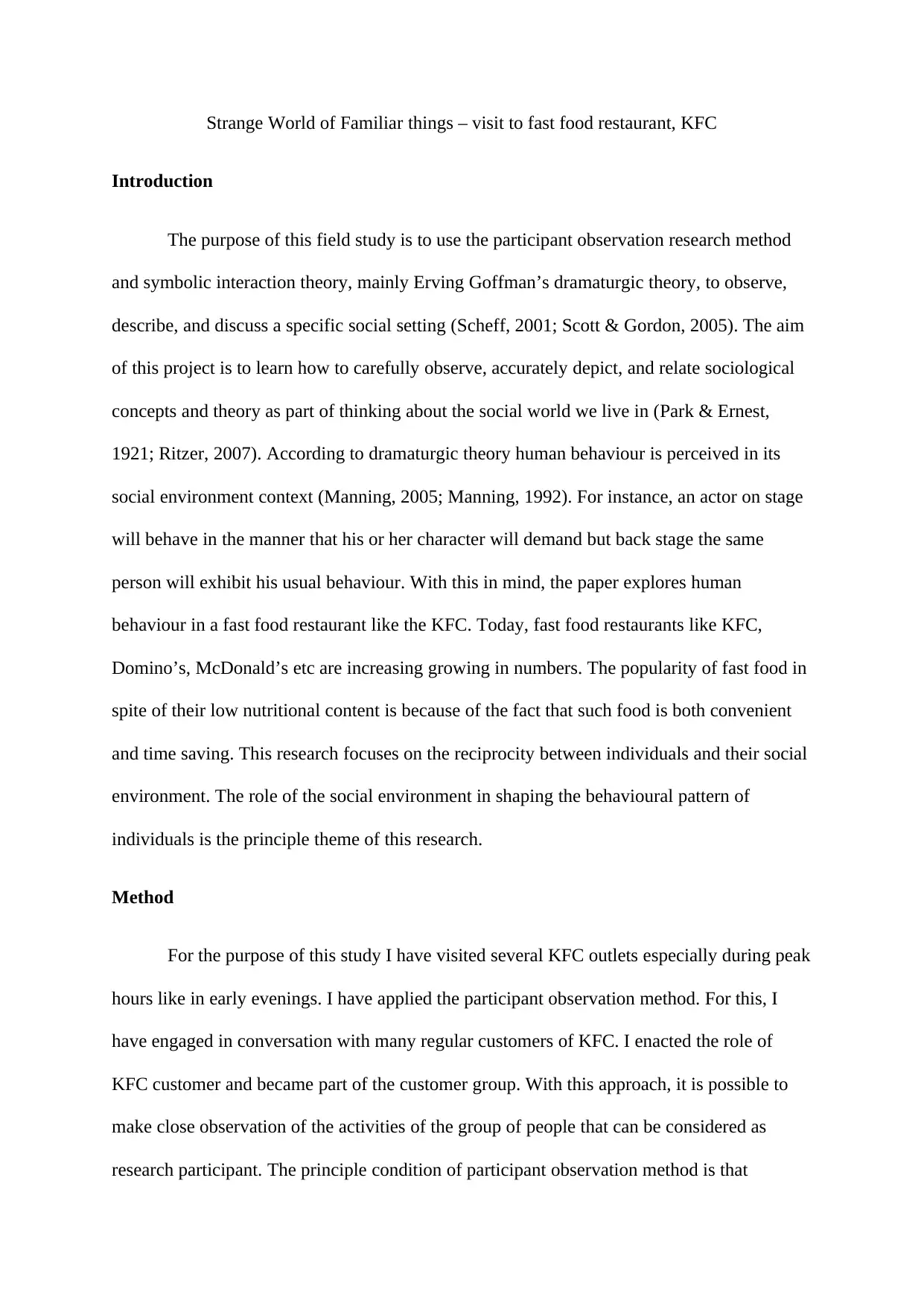
Strange World of Familiar things – visit to fast food restaurant, KFC
Introduction
The purpose of this field study is to use the participant observation research method
and symbolic interaction theory, mainly Erving Goffman’s dramaturgic theory, to observe,
describe, and discuss a specific social setting (Scheff, 2001; Scott & Gordon, 2005). The aim
of this project is to learn how to carefully observe, accurately depict, and relate sociological
concepts and theory as part of thinking about the social world we live in (Park & Ernest,
1921; Ritzer, 2007). According to dramaturgic theory human behaviour is perceived in its
social environment context (Manning, 2005; Manning, 1992). For instance, an actor on stage
will behave in the manner that his or her character will demand but back stage the same
person will exhibit his usual behaviour. With this in mind, the paper explores human
behaviour in a fast food restaurant like the KFC. Today, fast food restaurants like KFC,
Domino’s, McDonald’s etc are increasing growing in numbers. The popularity of fast food in
spite of their low nutritional content is because of the fact that such food is both convenient
and time saving. This research focuses on the reciprocity between individuals and their social
environment. The role of the social environment in shaping the behavioural pattern of
individuals is the principle theme of this research.
Method
For the purpose of this study I have visited several KFC outlets especially during peak
hours like in early evenings. I have applied the participant observation method. For this, I
have engaged in conversation with many regular customers of KFC. I enacted the role of
KFC customer and became part of the customer group. With this approach, it is possible to
make close observation of the activities of the group of people that can be considered as
research participant. The principle condition of participant observation method is that
Introduction
The purpose of this field study is to use the participant observation research method
and symbolic interaction theory, mainly Erving Goffman’s dramaturgic theory, to observe,
describe, and discuss a specific social setting (Scheff, 2001; Scott & Gordon, 2005). The aim
of this project is to learn how to carefully observe, accurately depict, and relate sociological
concepts and theory as part of thinking about the social world we live in (Park & Ernest,
1921; Ritzer, 2007). According to dramaturgic theory human behaviour is perceived in its
social environment context (Manning, 2005; Manning, 1992). For instance, an actor on stage
will behave in the manner that his or her character will demand but back stage the same
person will exhibit his usual behaviour. With this in mind, the paper explores human
behaviour in a fast food restaurant like the KFC. Today, fast food restaurants like KFC,
Domino’s, McDonald’s etc are increasing growing in numbers. The popularity of fast food in
spite of their low nutritional content is because of the fact that such food is both convenient
and time saving. This research focuses on the reciprocity between individuals and their social
environment. The role of the social environment in shaping the behavioural pattern of
individuals is the principle theme of this research.
Method
For the purpose of this study I have visited several KFC outlets especially during peak
hours like in early evenings. I have applied the participant observation method. For this, I
have engaged in conversation with many regular customers of KFC. I enacted the role of
KFC customer and became part of the customer group. With this approach, it is possible to
make close observation of the activities of the group of people that can be considered as
research participant. The principle condition of participant observation method is that
Paraphrase This Document
Need a fresh take? Get an instant paraphrase of this document with our AI Paraphraser
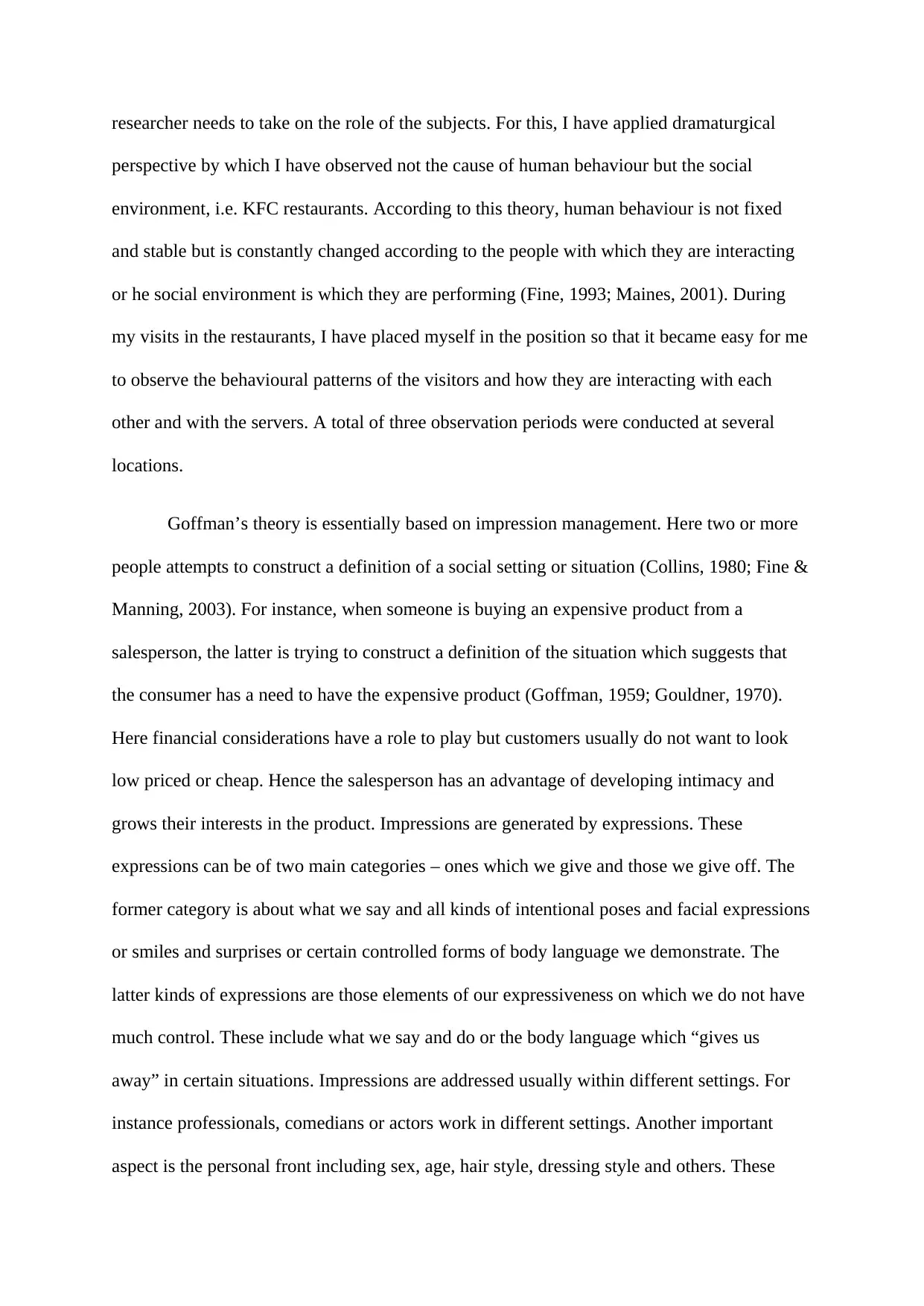
researcher needs to take on the role of the subjects. For this, I have applied dramaturgical
perspective by which I have observed not the cause of human behaviour but the social
environment, i.e. KFC restaurants. According to this theory, human behaviour is not fixed
and stable but is constantly changed according to the people with which they are interacting
or he social environment is which they are performing (Fine, 1993; Maines, 2001). During
my visits in the restaurants, I have placed myself in the position so that it became easy for me
to observe the behavioural patterns of the visitors and how they are interacting with each
other and with the servers. A total of three observation periods were conducted at several
locations.
Goffman’s theory is essentially based on impression management. Here two or more
people attempts to construct a definition of a social setting or situation (Collins, 1980; Fine &
Manning, 2003). For instance, when someone is buying an expensive product from a
salesperson, the latter is trying to construct a definition of the situation which suggests that
the consumer has a need to have the expensive product (Goffman, 1959; Gouldner, 1970).
Here financial considerations have a role to play but customers usually do not want to look
low priced or cheap. Hence the salesperson has an advantage of developing intimacy and
grows their interests in the product. Impressions are generated by expressions. These
expressions can be of two main categories – ones which we give and those we give off. The
former category is about what we say and all kinds of intentional poses and facial expressions
or smiles and surprises or certain controlled forms of body language we demonstrate. The
latter kinds of expressions are those elements of our expressiveness on which we do not have
much control. These include what we say and do or the body language which “gives us
away” in certain situations. Impressions are addressed usually within different settings. For
instance professionals, comedians or actors work in different settings. Another important
aspect is the personal front including sex, age, hair style, dressing style and others. These
perspective by which I have observed not the cause of human behaviour but the social
environment, i.e. KFC restaurants. According to this theory, human behaviour is not fixed
and stable but is constantly changed according to the people with which they are interacting
or he social environment is which they are performing (Fine, 1993; Maines, 2001). During
my visits in the restaurants, I have placed myself in the position so that it became easy for me
to observe the behavioural patterns of the visitors and how they are interacting with each
other and with the servers. A total of three observation periods were conducted at several
locations.
Goffman’s theory is essentially based on impression management. Here two or more
people attempts to construct a definition of a social setting or situation (Collins, 1980; Fine &
Manning, 2003). For instance, when someone is buying an expensive product from a
salesperson, the latter is trying to construct a definition of the situation which suggests that
the consumer has a need to have the expensive product (Goffman, 1959; Gouldner, 1970).
Here financial considerations have a role to play but customers usually do not want to look
low priced or cheap. Hence the salesperson has an advantage of developing intimacy and
grows their interests in the product. Impressions are generated by expressions. These
expressions can be of two main categories – ones which we give and those we give off. The
former category is about what we say and all kinds of intentional poses and facial expressions
or smiles and surprises or certain controlled forms of body language we demonstrate. The
latter kinds of expressions are those elements of our expressiveness on which we do not have
much control. These include what we say and do or the body language which “gives us
away” in certain situations. Impressions are addressed usually within different settings. For
instance professionals, comedians or actors work in different settings. Another important
aspect is the personal front including sex, age, hair style, dressing style and others. These
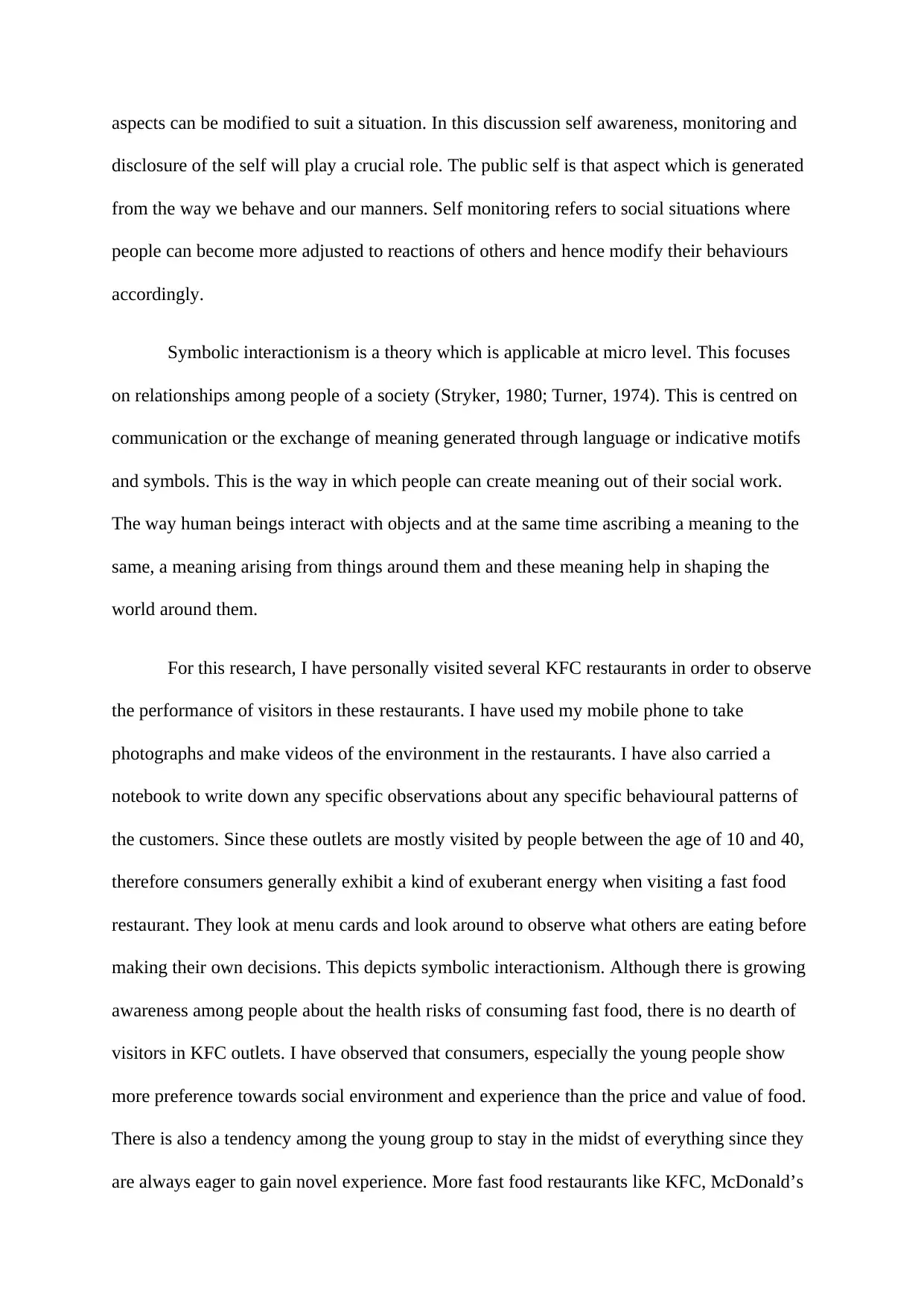
aspects can be modified to suit a situation. In this discussion self awareness, monitoring and
disclosure of the self will play a crucial role. The public self is that aspect which is generated
from the way we behave and our manners. Self monitoring refers to social situations where
people can become more adjusted to reactions of others and hence modify their behaviours
accordingly.
Symbolic interactionism is a theory which is applicable at micro level. This focuses
on relationships among people of a society (Stryker, 1980; Turner, 1974). This is centred on
communication or the exchange of meaning generated through language or indicative motifs
and symbols. This is the way in which people can create meaning out of their social work.
The way human beings interact with objects and at the same time ascribing a meaning to the
same, a meaning arising from things around them and these meaning help in shaping the
world around them.
For this research, I have personally visited several KFC restaurants in order to observe
the performance of visitors in these restaurants. I have used my mobile phone to take
photographs and make videos of the environment in the restaurants. I have also carried a
notebook to write down any specific observations about any specific behavioural patterns of
the customers. Since these outlets are mostly visited by people between the age of 10 and 40,
therefore consumers generally exhibit a kind of exuberant energy when visiting a fast food
restaurant. They look at menu cards and look around to observe what others are eating before
making their own decisions. This depicts symbolic interactionism. Although there is growing
awareness among people about the health risks of consuming fast food, there is no dearth of
visitors in KFC outlets. I have observed that consumers, especially the young people show
more preference towards social environment and experience than the price and value of food.
There is also a tendency among the young group to stay in the midst of everything since they
are always eager to gain novel experience. More fast food restaurants like KFC, McDonald’s
disclosure of the self will play a crucial role. The public self is that aspect which is generated
from the way we behave and our manners. Self monitoring refers to social situations where
people can become more adjusted to reactions of others and hence modify their behaviours
accordingly.
Symbolic interactionism is a theory which is applicable at micro level. This focuses
on relationships among people of a society (Stryker, 1980; Turner, 1974). This is centred on
communication or the exchange of meaning generated through language or indicative motifs
and symbols. This is the way in which people can create meaning out of their social work.
The way human beings interact with objects and at the same time ascribing a meaning to the
same, a meaning arising from things around them and these meaning help in shaping the
world around them.
For this research, I have personally visited several KFC restaurants in order to observe
the performance of visitors in these restaurants. I have used my mobile phone to take
photographs and make videos of the environment in the restaurants. I have also carried a
notebook to write down any specific observations about any specific behavioural patterns of
the customers. Since these outlets are mostly visited by people between the age of 10 and 40,
therefore consumers generally exhibit a kind of exuberant energy when visiting a fast food
restaurant. They look at menu cards and look around to observe what others are eating before
making their own decisions. This depicts symbolic interactionism. Although there is growing
awareness among people about the health risks of consuming fast food, there is no dearth of
visitors in KFC outlets. I have observed that consumers, especially the young people show
more preference towards social environment and experience than the price and value of food.
There is also a tendency among the young group to stay in the midst of everything since they
are always eager to gain novel experience. More fast food restaurants like KFC, McDonald’s
⊘ This is a preview!⊘
Do you want full access?
Subscribe today to unlock all pages.

Trusted by 1+ million students worldwide
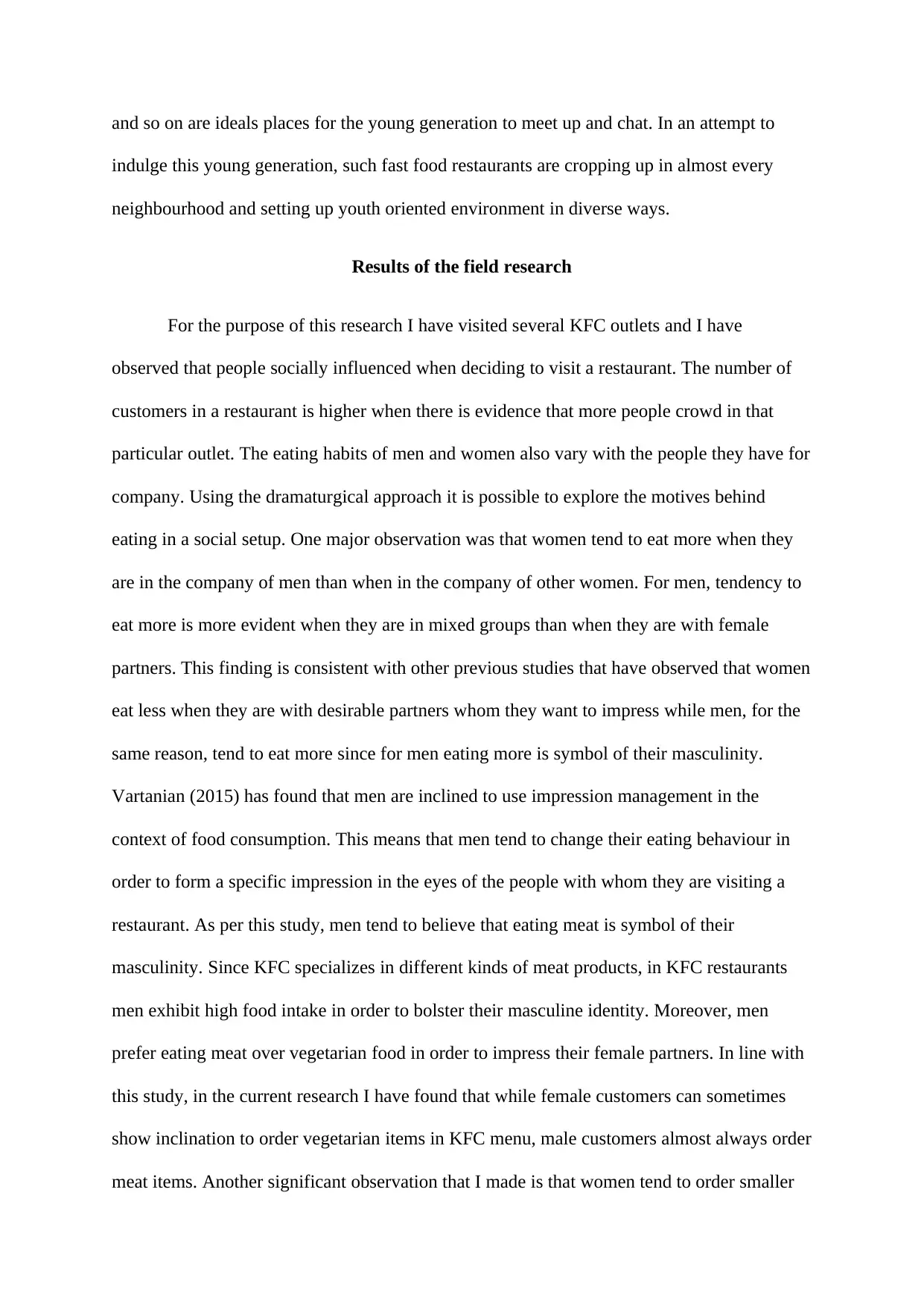
and so on are ideals places for the young generation to meet up and chat. In an attempt to
indulge this young generation, such fast food restaurants are cropping up in almost every
neighbourhood and setting up youth oriented environment in diverse ways.
Results of the field research
For the purpose of this research I have visited several KFC outlets and I have
observed that people socially influenced when deciding to visit a restaurant. The number of
customers in a restaurant is higher when there is evidence that more people crowd in that
particular outlet. The eating habits of men and women also vary with the people they have for
company. Using the dramaturgical approach it is possible to explore the motives behind
eating in a social setup. One major observation was that women tend to eat more when they
are in the company of men than when in the company of other women. For men, tendency to
eat more is more evident when they are in mixed groups than when they are with female
partners. This finding is consistent with other previous studies that have observed that women
eat less when they are with desirable partners whom they want to impress while men, for the
same reason, tend to eat more since for men eating more is symbol of their masculinity.
Vartanian (2015) has found that men are inclined to use impression management in the
context of food consumption. This means that men tend to change their eating behaviour in
order to form a specific impression in the eyes of the people with whom they are visiting a
restaurant. As per this study, men tend to believe that eating meat is symbol of their
masculinity. Since KFC specializes in different kinds of meat products, in KFC restaurants
men exhibit high food intake in order to bolster their masculine identity. Moreover, men
prefer eating meat over vegetarian food in order to impress their female partners. In line with
this study, in the current research I have found that while female customers can sometimes
show inclination to order vegetarian items in KFC menu, male customers almost always order
meat items. Another significant observation that I made is that women tend to order smaller
indulge this young generation, such fast food restaurants are cropping up in almost every
neighbourhood and setting up youth oriented environment in diverse ways.
Results of the field research
For the purpose of this research I have visited several KFC outlets and I have
observed that people socially influenced when deciding to visit a restaurant. The number of
customers in a restaurant is higher when there is evidence that more people crowd in that
particular outlet. The eating habits of men and women also vary with the people they have for
company. Using the dramaturgical approach it is possible to explore the motives behind
eating in a social setup. One major observation was that women tend to eat more when they
are in the company of men than when in the company of other women. For men, tendency to
eat more is more evident when they are in mixed groups than when they are with female
partners. This finding is consistent with other previous studies that have observed that women
eat less when they are with desirable partners whom they want to impress while men, for the
same reason, tend to eat more since for men eating more is symbol of their masculinity.
Vartanian (2015) has found that men are inclined to use impression management in the
context of food consumption. This means that men tend to change their eating behaviour in
order to form a specific impression in the eyes of the people with whom they are visiting a
restaurant. As per this study, men tend to believe that eating meat is symbol of their
masculinity. Since KFC specializes in different kinds of meat products, in KFC restaurants
men exhibit high food intake in order to bolster their masculine identity. Moreover, men
prefer eating meat over vegetarian food in order to impress their female partners. In line with
this study, in the current research I have found that while female customers can sometimes
show inclination to order vegetarian items in KFC menu, male customers almost always order
meat items. Another significant observation that I made is that women tend to order smaller
Paraphrase This Document
Need a fresh take? Get an instant paraphrase of this document with our AI Paraphraser
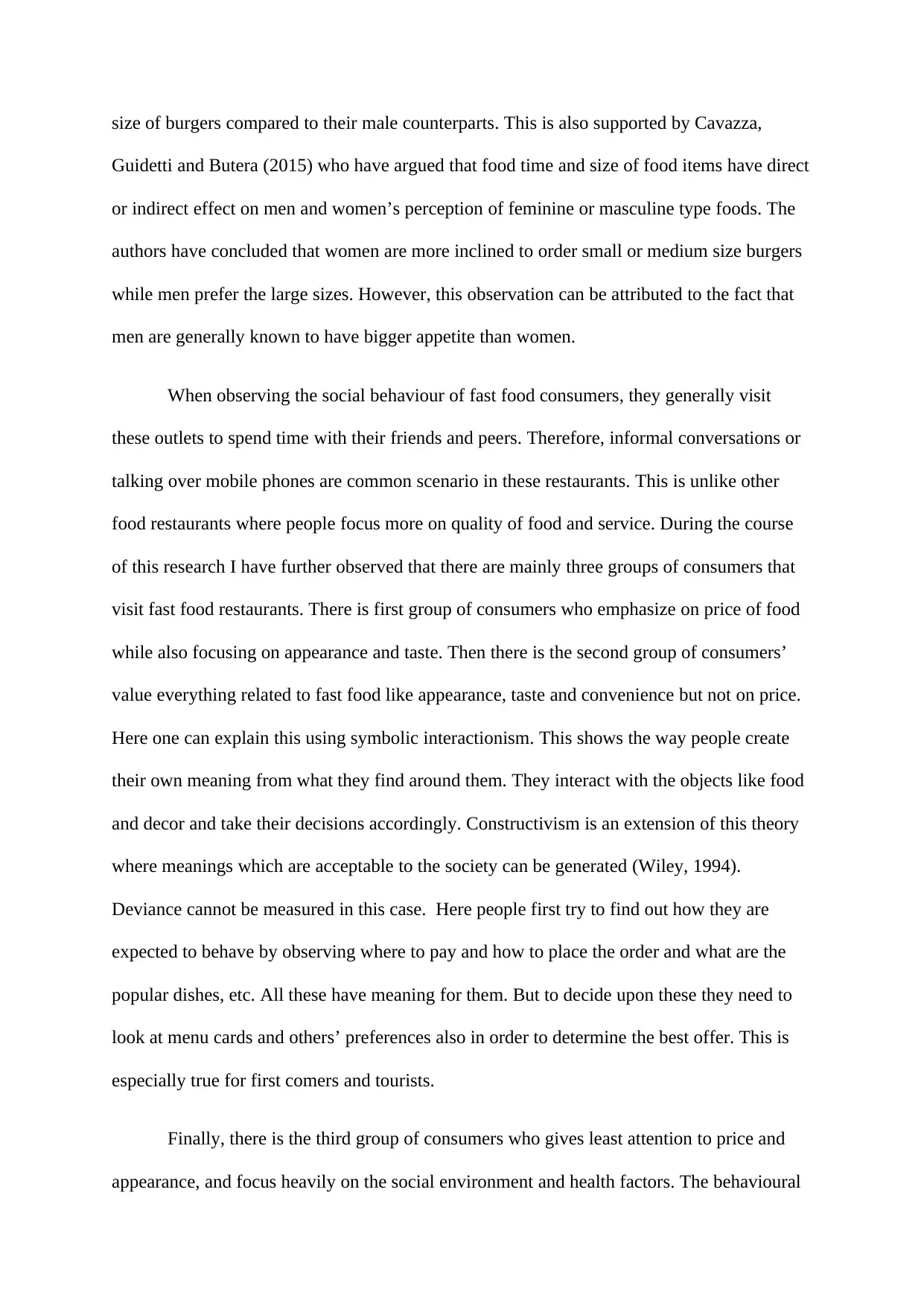
size of burgers compared to their male counterparts. This is also supported by Cavazza,
Guidetti and Butera (2015) who have argued that food time and size of food items have direct
or indirect effect on men and women’s perception of feminine or masculine type foods. The
authors have concluded that women are more inclined to order small or medium size burgers
while men prefer the large sizes. However, this observation can be attributed to the fact that
men are generally known to have bigger appetite than women.
When observing the social behaviour of fast food consumers, they generally visit
these outlets to spend time with their friends and peers. Therefore, informal conversations or
talking over mobile phones are common scenario in these restaurants. This is unlike other
food restaurants where people focus more on quality of food and service. During the course
of this research I have further observed that there are mainly three groups of consumers that
visit fast food restaurants. There is first group of consumers who emphasize on price of food
while also focusing on appearance and taste. Then there is the second group of consumers’
value everything related to fast food like appearance, taste and convenience but not on price.
Here one can explain this using symbolic interactionism. This shows the way people create
their own meaning from what they find around them. They interact with the objects like food
and decor and take their decisions accordingly. Constructivism is an extension of this theory
where meanings which are acceptable to the society can be generated (Wiley, 1994).
Deviance cannot be measured in this case. Here people first try to find out how they are
expected to behave by observing where to pay and how to place the order and what are the
popular dishes, etc. All these have meaning for them. But to decide upon these they need to
look at menu cards and others’ preferences also in order to determine the best offer. This is
especially true for first comers and tourists.
Finally, there is the third group of consumers who gives least attention to price and
appearance, and focus heavily on the social environment and health factors. The behavioural
Guidetti and Butera (2015) who have argued that food time and size of food items have direct
or indirect effect on men and women’s perception of feminine or masculine type foods. The
authors have concluded that women are more inclined to order small or medium size burgers
while men prefer the large sizes. However, this observation can be attributed to the fact that
men are generally known to have bigger appetite than women.
When observing the social behaviour of fast food consumers, they generally visit
these outlets to spend time with their friends and peers. Therefore, informal conversations or
talking over mobile phones are common scenario in these restaurants. This is unlike other
food restaurants where people focus more on quality of food and service. During the course
of this research I have further observed that there are mainly three groups of consumers that
visit fast food restaurants. There is first group of consumers who emphasize on price of food
while also focusing on appearance and taste. Then there is the second group of consumers’
value everything related to fast food like appearance, taste and convenience but not on price.
Here one can explain this using symbolic interactionism. This shows the way people create
their own meaning from what they find around them. They interact with the objects like food
and decor and take their decisions accordingly. Constructivism is an extension of this theory
where meanings which are acceptable to the society can be generated (Wiley, 1994).
Deviance cannot be measured in this case. Here people first try to find out how they are
expected to behave by observing where to pay and how to place the order and what are the
popular dishes, etc. All these have meaning for them. But to decide upon these they need to
look at menu cards and others’ preferences also in order to determine the best offer. This is
especially true for first comers and tourists.
Finally, there is the third group of consumers who gives least attention to price and
appearance, and focus heavily on the social environment and health factors. The behavioural
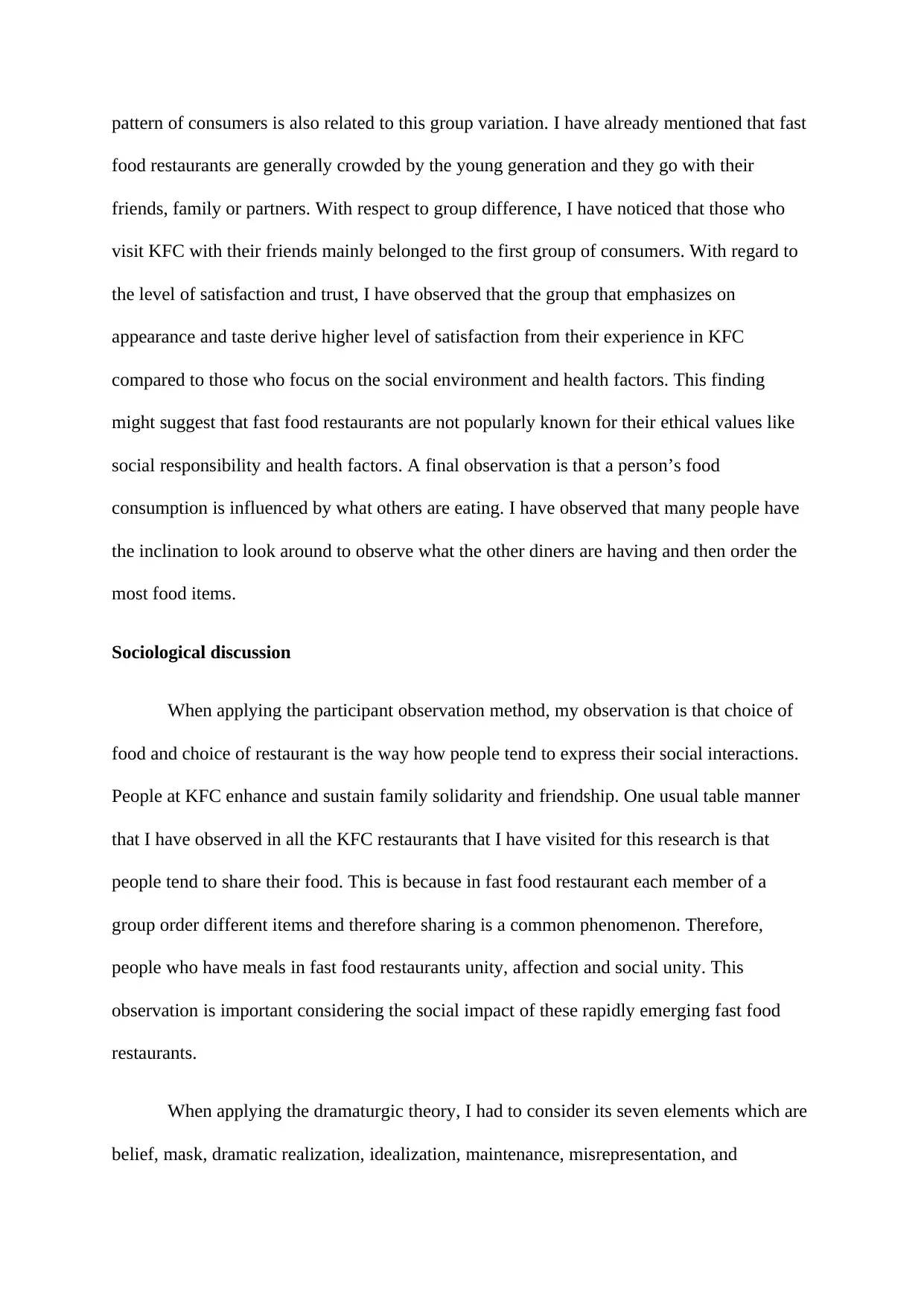
pattern of consumers is also related to this group variation. I have already mentioned that fast
food restaurants are generally crowded by the young generation and they go with their
friends, family or partners. With respect to group difference, I have noticed that those who
visit KFC with their friends mainly belonged to the first group of consumers. With regard to
the level of satisfaction and trust, I have observed that the group that emphasizes on
appearance and taste derive higher level of satisfaction from their experience in KFC
compared to those who focus on the social environment and health factors. This finding
might suggest that fast food restaurants are not popularly known for their ethical values like
social responsibility and health factors. A final observation is that a person’s food
consumption is influenced by what others are eating. I have observed that many people have
the inclination to look around to observe what the other diners are having and then order the
most food items.
Sociological discussion
When applying the participant observation method, my observation is that choice of
food and choice of restaurant is the way how people tend to express their social interactions.
People at KFC enhance and sustain family solidarity and friendship. One usual table manner
that I have observed in all the KFC restaurants that I have visited for this research is that
people tend to share their food. This is because in fast food restaurant each member of a
group order different items and therefore sharing is a common phenomenon. Therefore,
people who have meals in fast food restaurants unity, affection and social unity. This
observation is important considering the social impact of these rapidly emerging fast food
restaurants.
When applying the dramaturgic theory, I had to consider its seven elements which are
belief, mask, dramatic realization, idealization, maintenance, misrepresentation, and
food restaurants are generally crowded by the young generation and they go with their
friends, family or partners. With respect to group difference, I have noticed that those who
visit KFC with their friends mainly belonged to the first group of consumers. With regard to
the level of satisfaction and trust, I have observed that the group that emphasizes on
appearance and taste derive higher level of satisfaction from their experience in KFC
compared to those who focus on the social environment and health factors. This finding
might suggest that fast food restaurants are not popularly known for their ethical values like
social responsibility and health factors. A final observation is that a person’s food
consumption is influenced by what others are eating. I have observed that many people have
the inclination to look around to observe what the other diners are having and then order the
most food items.
Sociological discussion
When applying the participant observation method, my observation is that choice of
food and choice of restaurant is the way how people tend to express their social interactions.
People at KFC enhance and sustain family solidarity and friendship. One usual table manner
that I have observed in all the KFC restaurants that I have visited for this research is that
people tend to share their food. This is because in fast food restaurant each member of a
group order different items and therefore sharing is a common phenomenon. Therefore,
people who have meals in fast food restaurants unity, affection and social unity. This
observation is important considering the social impact of these rapidly emerging fast food
restaurants.
When applying the dramaturgic theory, I had to consider its seven elements which are
belief, mask, dramatic realization, idealization, maintenance, misrepresentation, and
⊘ This is a preview!⊘
Do you want full access?
Subscribe today to unlock all pages.

Trusted by 1+ million students worldwide
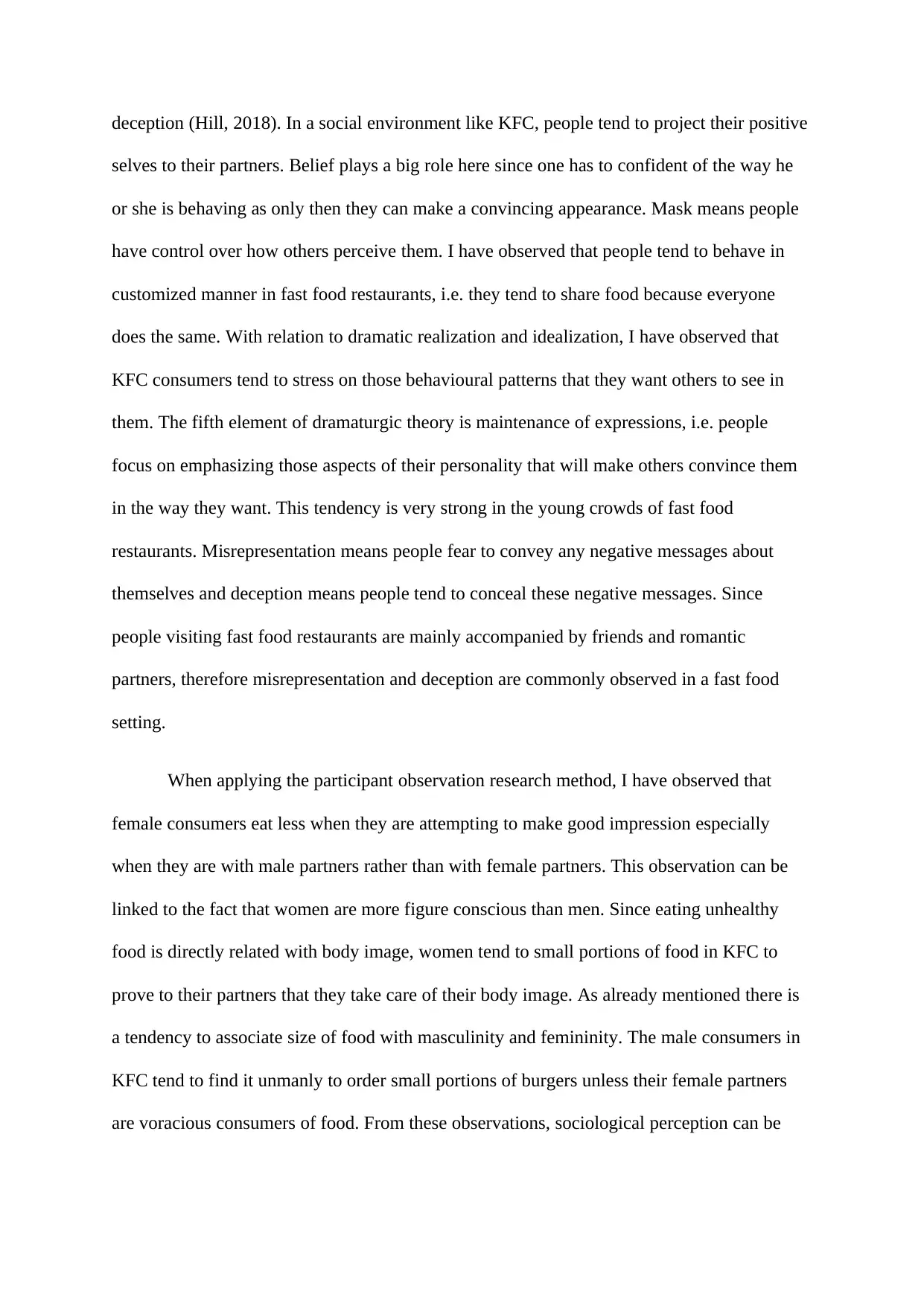
deception (Hill, 2018). In a social environment like KFC, people tend to project their positive
selves to their partners. Belief plays a big role here since one has to confident of the way he
or she is behaving as only then they can make a convincing appearance. Mask means people
have control over how others perceive them. I have observed that people tend to behave in
customized manner in fast food restaurants, i.e. they tend to share food because everyone
does the same. With relation to dramatic realization and idealization, I have observed that
KFC consumers tend to stress on those behavioural patterns that they want others to see in
them. The fifth element of dramaturgic theory is maintenance of expressions, i.e. people
focus on emphasizing those aspects of their personality that will make others convince them
in the way they want. This tendency is very strong in the young crowds of fast food
restaurants. Misrepresentation means people fear to convey any negative messages about
themselves and deception means people tend to conceal these negative messages. Since
people visiting fast food restaurants are mainly accompanied by friends and romantic
partners, therefore misrepresentation and deception are commonly observed in a fast food
setting.
When applying the participant observation research method, I have observed that
female consumers eat less when they are attempting to make good impression especially
when they are with male partners rather than with female partners. This observation can be
linked to the fact that women are more figure conscious than men. Since eating unhealthy
food is directly related with body image, women tend to small portions of food in KFC to
prove to their partners that they take care of their body image. As already mentioned there is
a tendency to associate size of food with masculinity and femininity. The male consumers in
KFC tend to find it unmanly to order small portions of burgers unless their female partners
are voracious consumers of food. From these observations, sociological perception can be
selves to their partners. Belief plays a big role here since one has to confident of the way he
or she is behaving as only then they can make a convincing appearance. Mask means people
have control over how others perceive them. I have observed that people tend to behave in
customized manner in fast food restaurants, i.e. they tend to share food because everyone
does the same. With relation to dramatic realization and idealization, I have observed that
KFC consumers tend to stress on those behavioural patterns that they want others to see in
them. The fifth element of dramaturgic theory is maintenance of expressions, i.e. people
focus on emphasizing those aspects of their personality that will make others convince them
in the way they want. This tendency is very strong in the young crowds of fast food
restaurants. Misrepresentation means people fear to convey any negative messages about
themselves and deception means people tend to conceal these negative messages. Since
people visiting fast food restaurants are mainly accompanied by friends and romantic
partners, therefore misrepresentation and deception are commonly observed in a fast food
setting.
When applying the participant observation research method, I have observed that
female consumers eat less when they are attempting to make good impression especially
when they are with male partners rather than with female partners. This observation can be
linked to the fact that women are more figure conscious than men. Since eating unhealthy
food is directly related with body image, women tend to small portions of food in KFC to
prove to their partners that they take care of their body image. As already mentioned there is
a tendency to associate size of food with masculinity and femininity. The male consumers in
KFC tend to find it unmanly to order small portions of burgers unless their female partners
are voracious consumers of food. From these observations, sociological perception can be
Paraphrase This Document
Need a fresh take? Get an instant paraphrase of this document with our AI Paraphraser
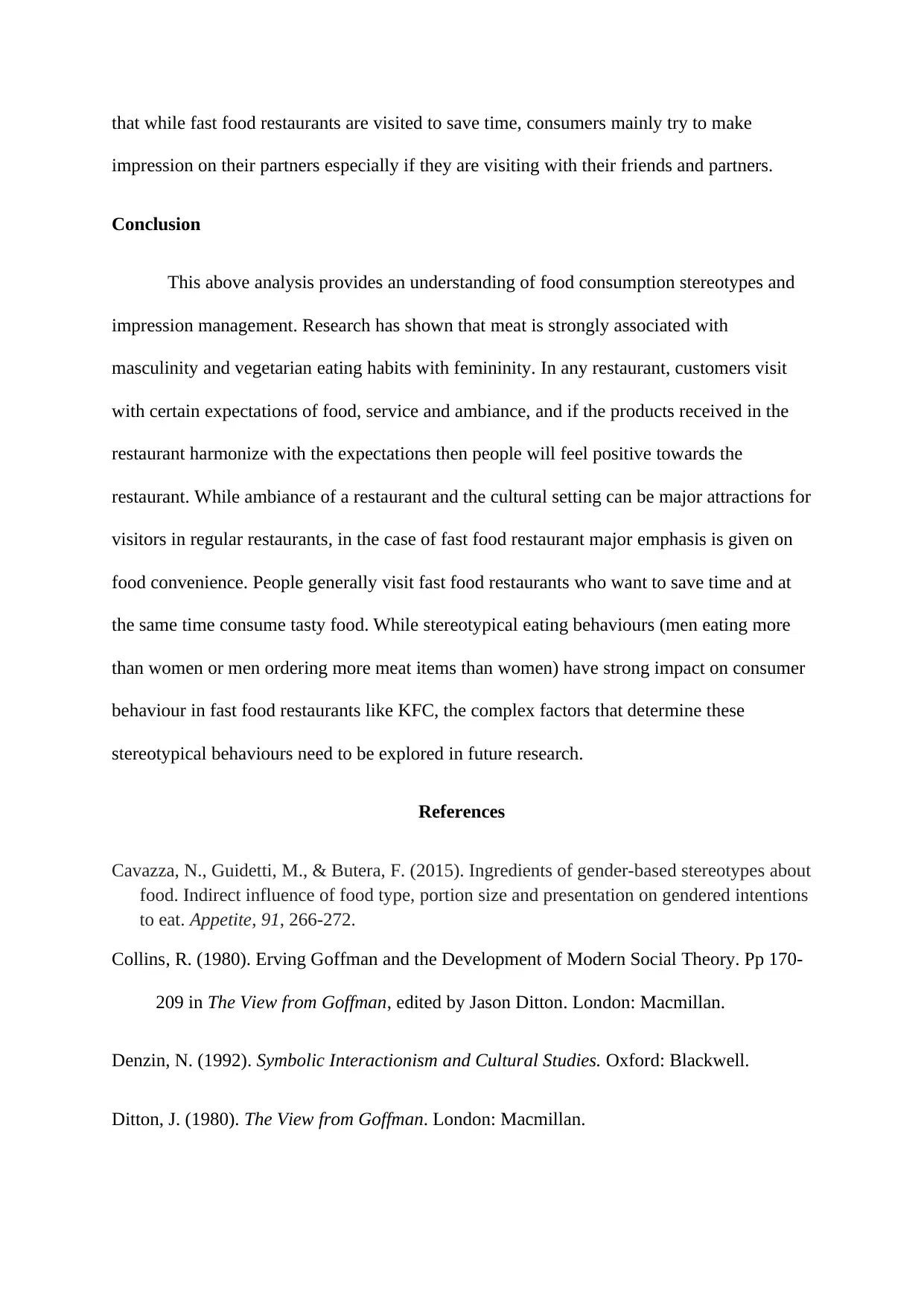
that while fast food restaurants are visited to save time, consumers mainly try to make
impression on their partners especially if they are visiting with their friends and partners.
Conclusion
This above analysis provides an understanding of food consumption stereotypes and
impression management. Research has shown that meat is strongly associated with
masculinity and vegetarian eating habits with femininity. In any restaurant, customers visit
with certain expectations of food, service and ambiance, and if the products received in the
restaurant harmonize with the expectations then people will feel positive towards the
restaurant. While ambiance of a restaurant and the cultural setting can be major attractions for
visitors in regular restaurants, in the case of fast food restaurant major emphasis is given on
food convenience. People generally visit fast food restaurants who want to save time and at
the same time consume tasty food. While stereotypical eating behaviours (men eating more
than women or men ordering more meat items than women) have strong impact on consumer
behaviour in fast food restaurants like KFC, the complex factors that determine these
stereotypical behaviours need to be explored in future research.
References
Cavazza, N., Guidetti, M., & Butera, F. (2015). Ingredients of gender-based stereotypes about
food. Indirect influence of food type, portion size and presentation on gendered intentions
to eat. Appetite, 91, 266-272.
Collins, R. (1980). Erving Goffman and the Development of Modern Social Theory. Pp 170-
209 in The View from Goffman, edited by Jason Ditton. London: Macmillan.
Denzin, N. (1992). Symbolic Interactionism and Cultural Studies. Oxford: Blackwell.
Ditton, J. (1980). The View from Goffman. London: Macmillan.
impression on their partners especially if they are visiting with their friends and partners.
Conclusion
This above analysis provides an understanding of food consumption stereotypes and
impression management. Research has shown that meat is strongly associated with
masculinity and vegetarian eating habits with femininity. In any restaurant, customers visit
with certain expectations of food, service and ambiance, and if the products received in the
restaurant harmonize with the expectations then people will feel positive towards the
restaurant. While ambiance of a restaurant and the cultural setting can be major attractions for
visitors in regular restaurants, in the case of fast food restaurant major emphasis is given on
food convenience. People generally visit fast food restaurants who want to save time and at
the same time consume tasty food. While stereotypical eating behaviours (men eating more
than women or men ordering more meat items than women) have strong impact on consumer
behaviour in fast food restaurants like KFC, the complex factors that determine these
stereotypical behaviours need to be explored in future research.
References
Cavazza, N., Guidetti, M., & Butera, F. (2015). Ingredients of gender-based stereotypes about
food. Indirect influence of food type, portion size and presentation on gendered intentions
to eat. Appetite, 91, 266-272.
Collins, R. (1980). Erving Goffman and the Development of Modern Social Theory. Pp 170-
209 in The View from Goffman, edited by Jason Ditton. London: Macmillan.
Denzin, N. (1992). Symbolic Interactionism and Cultural Studies. Oxford: Blackwell.
Ditton, J. (1980). The View from Goffman. London: Macmillan.
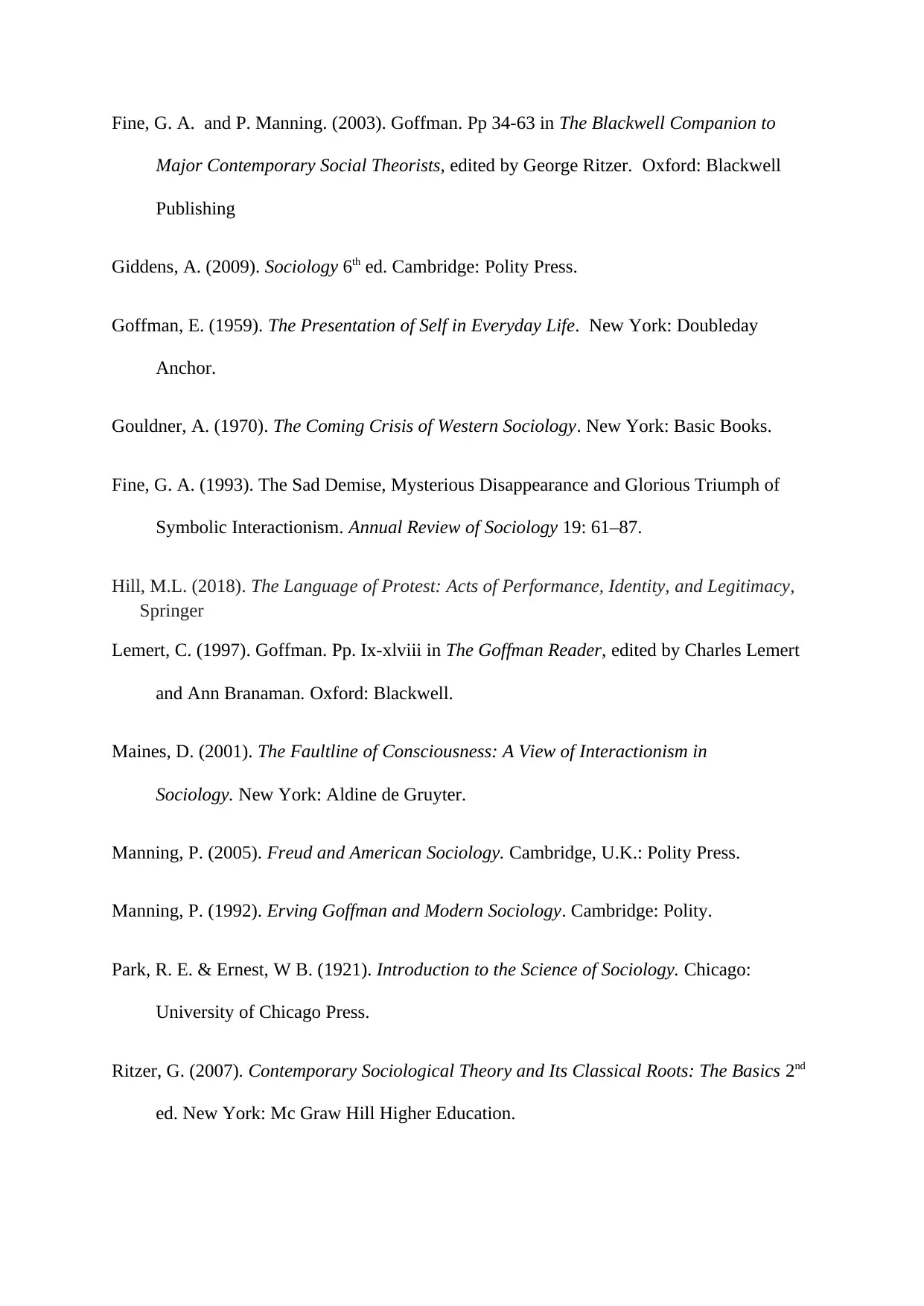
Fine, G. A. and P. Manning. (2003). Goffman. Pp 34-63 in The Blackwell Companion to
Major Contemporary Social Theorists, edited by George Ritzer. Oxford: Blackwell
Publishing
Giddens, A. (2009). Sociology 6th ed. Cambridge: Polity Press.
Goffman, E. (1959). The Presentation of Self in Everyday Life. New York: Doubleday
Anchor.
Gouldner, A. (1970). The Coming Crisis of Western Sociology. New York: Basic Books.
Fine, G. A. (1993). The Sad Demise, Mysterious Disappearance and Glorious Triumph of
Symbolic Interactionism. Annual Review of Sociology 19: 61–87.
Hill, M.L. (2018). The Language of Protest: Acts of Performance, Identity, and Legitimacy,
Springer
Lemert, C. (1997). Goffman. Pp. Ix-xlviii in The Goffman Reader, edited by Charles Lemert
and Ann Branaman. Oxford: Blackwell.
Maines, D. (2001). The Faultline of Consciousness: A View of Interactionism in
Sociology. New York: Aldine de Gruyter.
Manning, P. (2005). Freud and American Sociology. Cambridge, U.K.: Polity Press.
Manning, P. (1992). Erving Goffman and Modern Sociology. Cambridge: Polity.
Park, R. E. & Ernest, W B. (1921). Introduction to the Science of Sociology. Chicago:
University of Chicago Press.
Ritzer, G. (2007). Contemporary Sociological Theory and Its Classical Roots: The Basics 2nd
ed. New York: Mc Graw Hill Higher Education.
Major Contemporary Social Theorists, edited by George Ritzer. Oxford: Blackwell
Publishing
Giddens, A. (2009). Sociology 6th ed. Cambridge: Polity Press.
Goffman, E. (1959). The Presentation of Self in Everyday Life. New York: Doubleday
Anchor.
Gouldner, A. (1970). The Coming Crisis of Western Sociology. New York: Basic Books.
Fine, G. A. (1993). The Sad Demise, Mysterious Disappearance and Glorious Triumph of
Symbolic Interactionism. Annual Review of Sociology 19: 61–87.
Hill, M.L. (2018). The Language of Protest: Acts of Performance, Identity, and Legitimacy,
Springer
Lemert, C. (1997). Goffman. Pp. Ix-xlviii in The Goffman Reader, edited by Charles Lemert
and Ann Branaman. Oxford: Blackwell.
Maines, D. (2001). The Faultline of Consciousness: A View of Interactionism in
Sociology. New York: Aldine de Gruyter.
Manning, P. (2005). Freud and American Sociology. Cambridge, U.K.: Polity Press.
Manning, P. (1992). Erving Goffman and Modern Sociology. Cambridge: Polity.
Park, R. E. & Ernest, W B. (1921). Introduction to the Science of Sociology. Chicago:
University of Chicago Press.
Ritzer, G. (2007). Contemporary Sociological Theory and Its Classical Roots: The Basics 2nd
ed. New York: Mc Graw Hill Higher Education.
⊘ This is a preview!⊘
Do you want full access?
Subscribe today to unlock all pages.

Trusted by 1+ million students worldwide
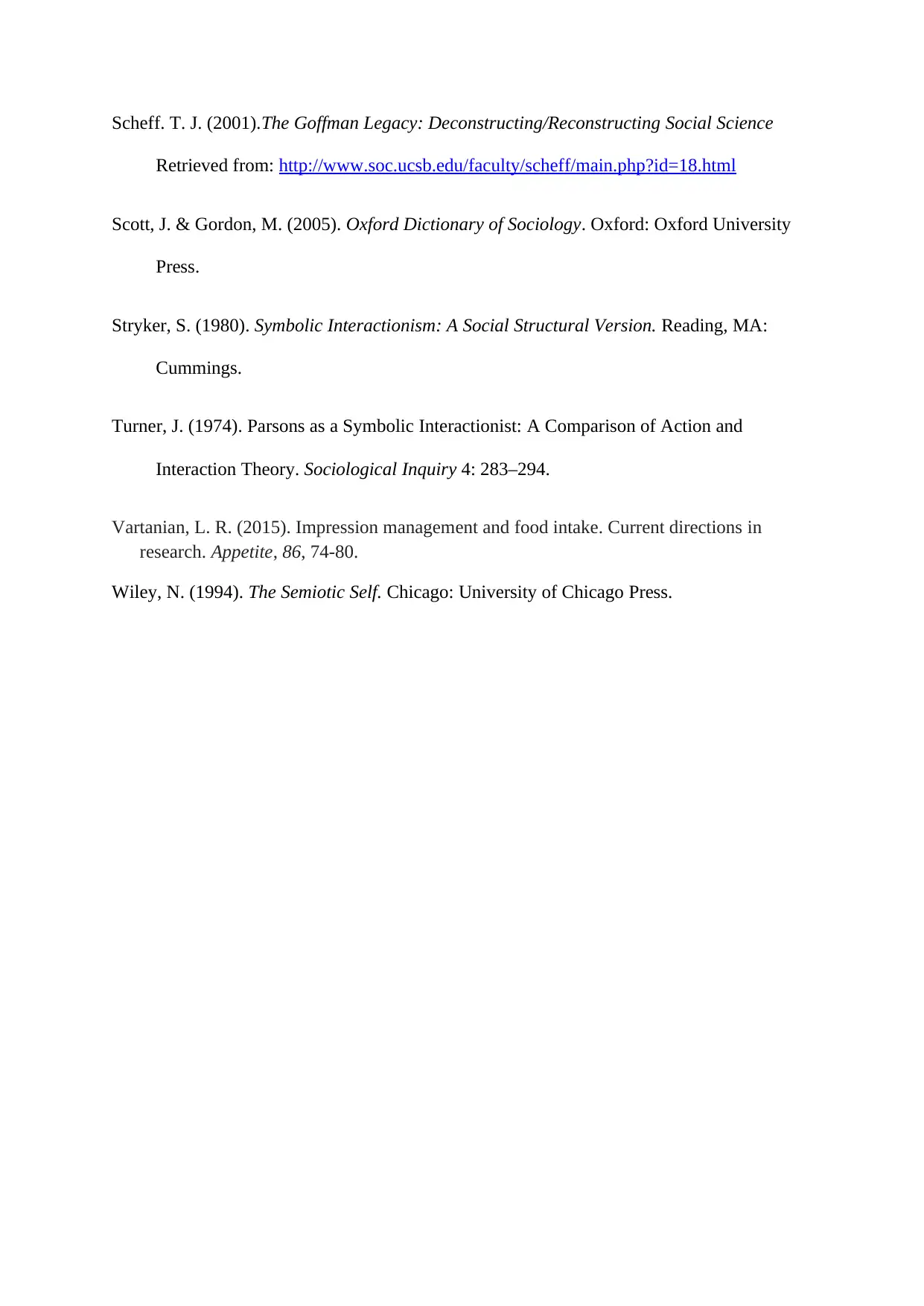
Scheff. T. J. (2001).The Goffman Legacy: Deconstructing/Reconstructing Social Science
Retrieved from: http://www.soc.ucsb.edu/faculty/scheff/main.php?id=18.html
Scott, J. & Gordon, M. (2005). Oxford Dictionary of Sociology. Oxford: Oxford University
Press.
Stryker, S. (1980). Symbolic Interactionism: A Social Structural Version. Reading, MA:
Cummings.
Turner, J. (1974). Parsons as a Symbolic Interactionist: A Comparison of Action and
Interaction Theory. Sociological Inquiry 4: 283–294.
Vartanian, L. R. (2015). Impression management and food intake. Current directions in
research. Appetite, 86, 74-80.
Wiley, N. (1994). The Semiotic Self. Chicago: University of Chicago Press.
Retrieved from: http://www.soc.ucsb.edu/faculty/scheff/main.php?id=18.html
Scott, J. & Gordon, M. (2005). Oxford Dictionary of Sociology. Oxford: Oxford University
Press.
Stryker, S. (1980). Symbolic Interactionism: A Social Structural Version. Reading, MA:
Cummings.
Turner, J. (1974). Parsons as a Symbolic Interactionist: A Comparison of Action and
Interaction Theory. Sociological Inquiry 4: 283–294.
Vartanian, L. R. (2015). Impression management and food intake. Current directions in
research. Appetite, 86, 74-80.
Wiley, N. (1994). The Semiotic Self. Chicago: University of Chicago Press.
Paraphrase This Document
Need a fresh take? Get an instant paraphrase of this document with our AI Paraphraser

1 out of 11
Related Documents
Your All-in-One AI-Powered Toolkit for Academic Success.
+13062052269
info@desklib.com
Available 24*7 on WhatsApp / Email
![[object Object]](/_next/static/media/star-bottom.7253800d.svg)
Unlock your academic potential
Copyright © 2020–2025 A2Z Services. All Rights Reserved. Developed and managed by ZUCOL.



